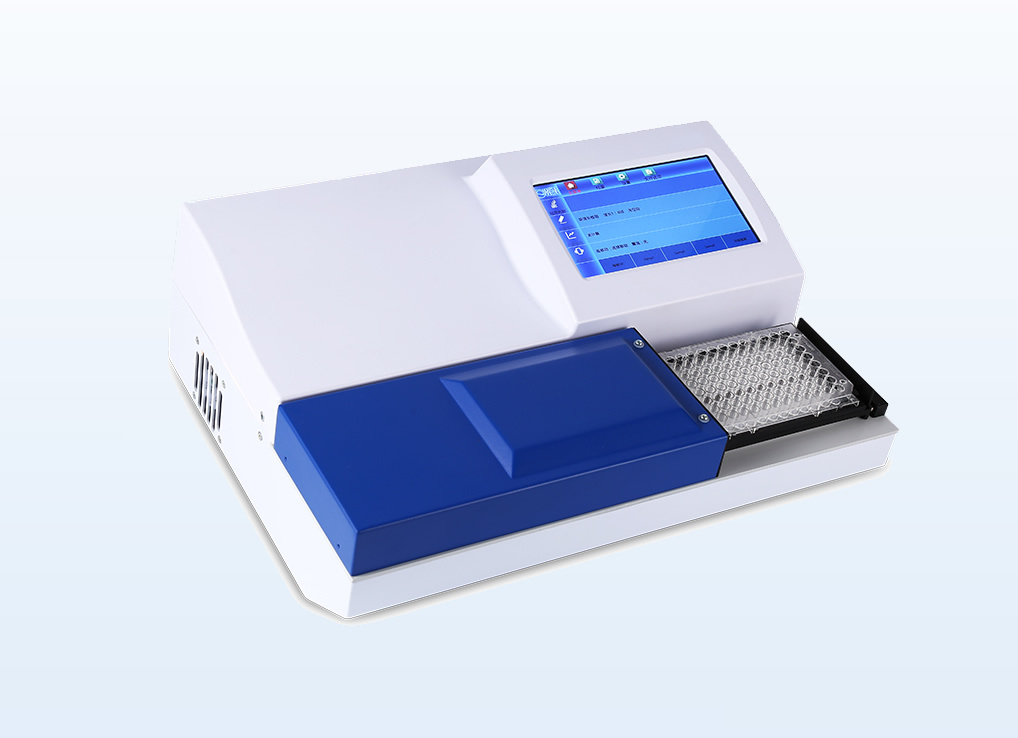ELISA plate reader
ELISA plate reader, An Enzyme-Linked Immunosorbent Assay (ELISA) machine, also known as an ELISA reader or ELISA plate reader, is a specialized laboratory instrument used to perform ELISA tests. ELISA is a sensitive and widely used technique in immunology and molecular biology for detecting the presence and concentration of specific proteins or antibodies in biological samples such as blood, serum, urine, or cell lysates. ELISA assays are commonly used in medical diagnostics, research, and various other applications.
Here are the key components and functions of an ELISA machine:
- Plate Holder: ELISA plates, typically 96-well microtiter plates, are loaded into the machine’s plate holder. These plates contain the samples and reagents needed for the assay.
- Optical System: ELISA machines are equipped with an optical system that can measure absorbance or fluorescence. The choice of detection method (absorbance or fluorescence) depends on the specific ELISA protocol and the type of labels used (e.g., enzyme-linked antibodies, fluorescent labels).
- Light Source: An ELISA machine typically has a light source that emits the appropriate wavelength of light for the chosen detection method. For absorbance-based ELISAs, emits visible light, while for fluorescence-based ELISAs, it emits excitation light.
- Detector: The machine’s detector measures the amount of light absorbed or emitted by the samples in the microtiter plate. This information is used to quantify the presence and concentration of the target analyte (e.g., antigen or antibody) in the samples.
- Temperature Control: Many ELISA machines have temperature control systems to maintain a constant temperature during the assay. This is important for assays that require incubation steps to ensure accurate results.
- Data Analysis Software: ELISA machines are typically connected to a computer with specialized software for data acquisition and analysis. The software helps calculate the concentration of the target analyte based on the measured absorbance or fluorescence values.
- Dispensing System (Optional): Some ELISA machines may also have automated dispensing systems to add reagents to the microtiter plate wells, reducing the risk of human error and improving assay reproducibility.
The workflow of using an ELISA machine generally involves the following steps:
- Prepare the ELISA plate with samples, standards, controls, and reagents.
- Insert the plate into the machine’s plate holder.
- Select the appropriate detection method (absorbance or fluorescence) and configure the machine settings.
- Initiate the assay, which may include incubation and washing steps, during which the machine measures absorbance or fluorescence at specific time points.
- The data analysis software processes the measurements and generates a standard curve or calculates the concentration of the target analyte in the samples.
- Results are typically displayed on the computer screen and can be printed or saved for further analysis.
ELISA machines come in various models and configurations, catering to the specific needs of different laboratories and research applications. They are essential tools for researchers and clinical laboratories to perform quantitative and qualitative analyses of biomolecules like proteins and antibodies.



[…] immunoassay (EIA) or enzyme-linked immunosorbent assay (ELISA): This test looks for antibodies produced by your immune system in response to the Lyme […]
[…] In addition to mixing, some roller mixers also double as incubators. They can maintain a controlled temperature and humidity environment for cell culture or other biological […]